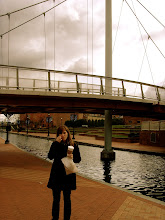"It's interesting...because in my culture, we hold images in such high value."
Last Thursday, I found myself standing on the balcony, overlooking the sand mandala in the library. I was explaining to a boy about the dissolution ceremony the monks would perform on their image the following day. After working almost non-stop for three days, they would dismantle the mandala and cast the sand into a nearby body of water. According to the monks, the dismantling symbolizes the releasing of the deity. The casting of the sand symbolizes the "impermanence of all things and the importance of non attachments." And further, when the sand hits the water, the "kindness and compassion of the deity are disseminated into the world to benefit all things."
Okay, so I'm by no means an expert on Tibetan Buddhism, but something really struck me about the monks' presence on campus, as well as the construction of the mandala. My surface-level intrigue came simply from what they were doing. The tools they used. The variety of colors. Their already-memorization of the image's structure and design (there are numerous types of mandalas, and monks often have several memorized, if not all). Its three-dimensionality. The intricate details. The careful and alert energy they had to put into its construction. All these elements, woven together, somehow just awed me. Plus, I got to try for myself and it is incredibly hard.
I guess too, once again, I stood face to face an American culture I'm finding harder and harder to be proud of. For instance, last Tuesday, I asked the one English-speaking monk how long he had been constructing mandalas. His response: "Oh, many many years." My response: "Awesome." Awesome? Really Kelly? You just said awesome to an old, wise, Tibetan monk? He didn't seem to think anything of it, but upon leaving the site I could only shake my head and silently laugh at myself.
Secondly, Kristin saw the monks walking across the library bridge on Friday, specifically mentioning how slow they were walking in comparison to everyone else; that they were walking at at least half the pace as those surrounding them. Even in something so simple as a walking speed...the difference in Western and Eastern culture. Upon hearing this, I thought back to the monks' quiet, almost serene, nature that I had witnessed over the past couple of days, when checking up on their progress. It was a sharp contrast to the American norm we see around us everyday.
I'm not quite sure if there is a specific lesson I'm trying to get at here. It was just refreshing and real; and for some reason, gave me some feelings of contentment. It's just nice to have new outlooks and experiences every now and then. Keeps life interesting.
4 years ago



2 comments:
the sand mandala was so very intriguing! i'm glad we both got to see it. your precious little monks...aww. well i think this post was well worth your time today in the library.
My cure all for a distaste for American culture was the road trip. I can't lie, I'm currently caught up in a whirlwind romance with American culture right now. But don't group everyone else just because you said "awesome". You were on your own there. The rest of the West is much more sophisticated than that. ;)
So with Western culture quickly spreading and the more "eastern" culture such as this monk culture declining, what is the appeal aside from the capitalistic side? I would include the 'do whats best for yourself' attitude and the wealth that most western countries have. Aside from that, why is so alluring? Or is that even why its spreading? Is it maybe spreading more by the force of influence from both the militaristic and economic reach of the West?
Spread of Western culture by force or choice?
Post a Comment